
| Capability (C007):— representing_state_type | Date: 2008/01/28 13:34:35 Revision: 1.14 |
This section provides a business level overview of this capability.
A state of someone or something, is referring to the condition they are in or what they are like at a particular time.
State definition defines the types of states that can, or can be expected to, exist.
This section provides an overview of the information model that supports this capability.
The state type capability is based on the State definition module for which there are three basic constructs:
NOTE A relationship between state definitions could be specialized to describe:
A state type is represented as a State_definition entity. The name and description of a state type should be defined as reference data being assigned to the State_definition representing the state type. The representation and assignment of reference data is described in the C010: assigning_reference_data capability.
EXAMPLE A typical class of state definitions that can be defined as reference data is "Failure mode".

A state type is defined by a condition, or a set of conditions, to which someone or something has to comply in order to be in the defined state.
The condition should be and assigned to the State_definition using the constructs of the C026: representing_condition capability.
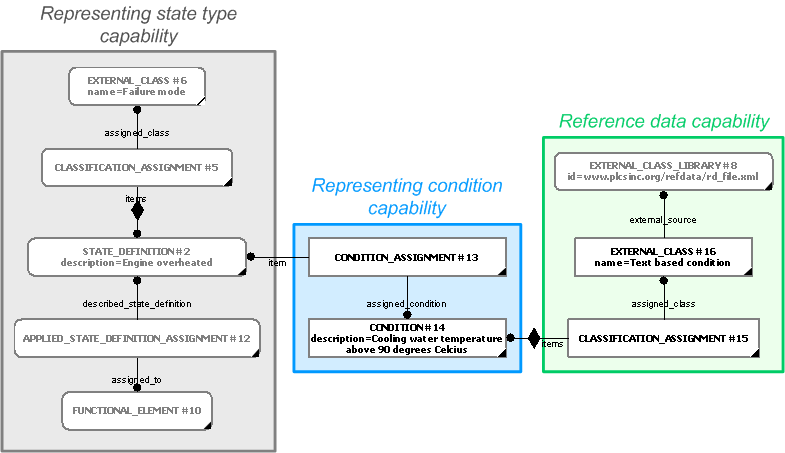
A state definition relationship can be classified using the C010: assigning_reference_data capability.
EXAMPLE An example of a class of state definition relationship that can be defined as reference data is "Failure effect".
The model allows for two different ways to descibe the purpose of a State_definition assignment:
EXAMPLE An example of Applied_state_definition_assignment reference data is; "Valid for".
NOTE Enumeration of entity types that a State_definition can be assigned to is outside the scope of this capability.
No further characteization of State_definition, State_definition_relationship and Applied_state_definition_assignment is needed to enable this capability.
The following sections define a set of templates for the capability, where a template is a specification of a set of entities that need to be instantiated to represent a given set of information.
This section specifies the template assigning_state_type.
NOTE An explanation of a template and the associated instantiation path is provided in the Template overview section.
This template describes how to represent state definitions (types of states), how to assign the state definition to something, and how to reference a state definition within a data set.
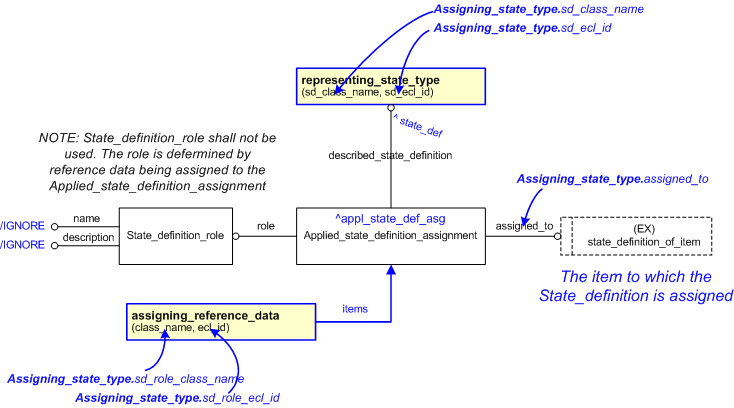

target
is the parameter to which the
Applied_state_definition_assignment
is bound.
target
is the parameter to which the
State_definition
is bound.
| Entity in path | Value | Inherited from |
| State_definition_role.name | '/IGNORE' | — |
| State_definition_role.description | '/IGNORE' | — |
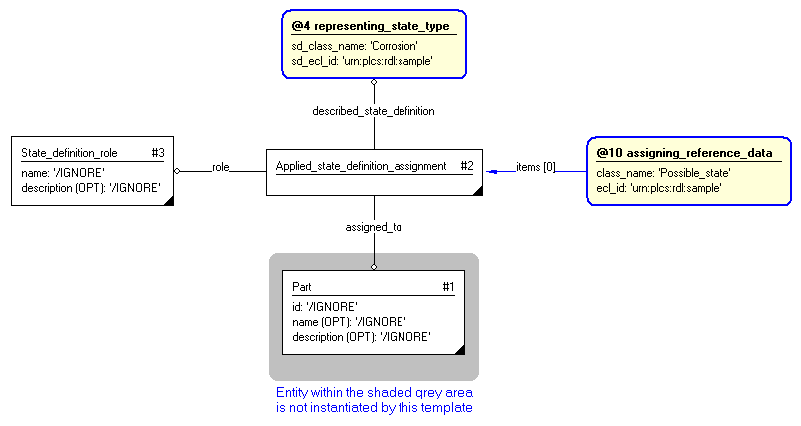
#1 = PART('/IGNORE','/IGNORE','/IGNORE'); #3 = STATE_DEFINITION('/IGNORE','/IGNORE'); #4 = STATE_DEFINITION_ROLE('/IGNORE','/IGNORE'); #5 = APPLIED_STATE_DEFINITION_ASSIGNMENT(#3,#1,#4); #7 = CLASSIFICATION_ASSIGNMENT(#9,(#3),'/IGNORE'); #9 = EXTERNAL_CLASS('/NULL','Corrosion','/IGNORE',#10); #10 = EXTERNAL_CLASS_LIBRARY('urn:plcs:rdl:sample',$); #12 = CLASSIFICATION_ASSIGNMENT(#14,(#5),'/IGNORE'); #14 = EXTERNAL_CLASS('/NULL','Possible_state','/IGNORE',#10);
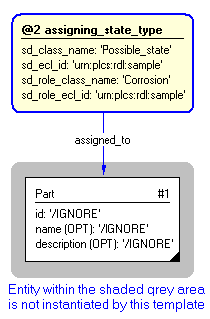
NOTE this characterization is optional.
Descriptions can be assigned to the State_definition using assigning_descriptor, e.g. in order to describe a state type that than can be classified. This is useful e.g. in creating a Failure Modes and Effects and Criticality Analysis (FMECA).
NOTE this characterization is optional.
Justifications can be assigned to the Applied_state_definition_assignment using assigning_justification, e.g. in order to define the circumstances that justifies a possible state.
This has been raised as issue, GYL-2, against ISO 10303-239. The EXPRESS schema has been modified in DEXlib (Long form: dexlib/data/schemas/ap239_arm_lf.exp, short form: dexlib/data/schemas/ap239_arm_sf.exp). These changes will be made to ISO 10303-239 as a Technical Corrigendum at some stage.
NOTE this characterization is optional.
Activities can be assigned to the Applied_state_definition_assignment using assigning_activity, e.g. in order to describe activities/events that may be a consequence of a defined state type.
This section specifies the template representing_state_type.
NOTE An explanation of a template and the associated instantiation path is provided in the Template overview section.
This template describes how to represent state definitions. State definitions define the types of states that can, or can be expected to, exist.
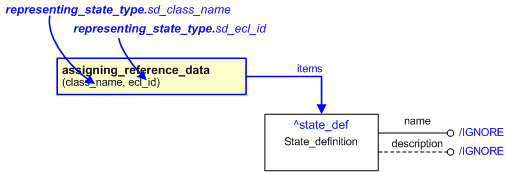

target
is the parameter to which the
State_definition
is bound.
| Entity in path | Value | Inherited from |
| State_definition.name | '/IGNORE' | — |
| State_definition.description | '/IGNORE' | — |

#1 = STATE_DEFINITION('/IGNORE','/IGNORE'); #2 = EXTERNAL_CLASS_LIBRARY('urn:plcs:rdl:sample','/IGNORE'); #3 = EXTERNAL_CLASS('/NULL','Engine_overheated','/IGNORE',#2); #4 = CLASSIFICATION_ASSIGNMENT(#3,(#1),'/IGNORE');

This capability "Representing State Type" is related to the following capabilities:
This capability "Representing State Type" is dependent on the following capabilities:
© OASIS 2010 — All rights reserved